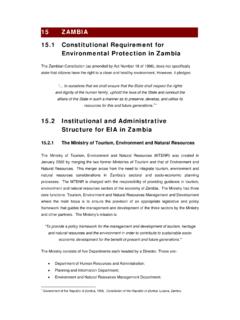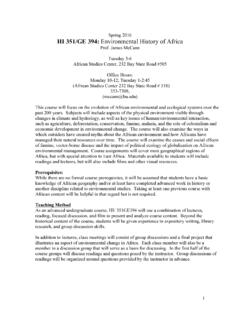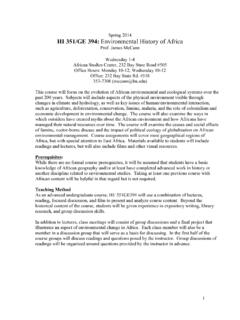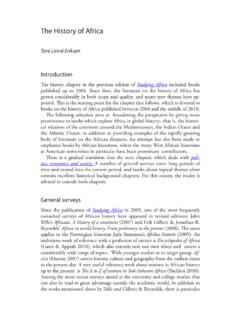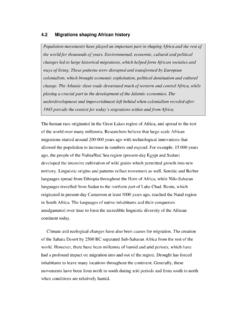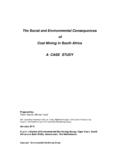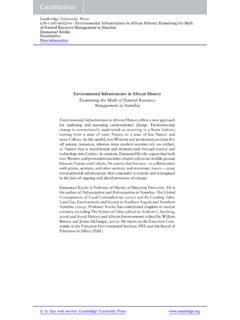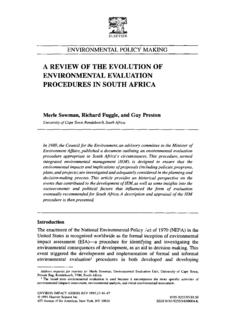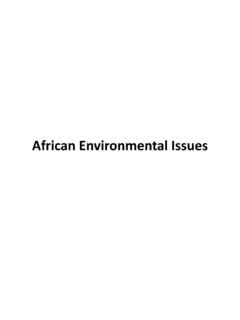Transcription of 3.2.9 South Africa a) Governance - saiea.com
1 South Africa a) Governance South Africa 's history is marked by the apartheid legacy of colonialism, racism, sexism, violence and repressive laws. As a result, poverty and degradation stand side by side with modern cities, developed mining, and commercial infrastructure. Indians, Africans and 'Coloureds' were prevented from free involvement in the political, social and economic life of the country even before the apartheid era. After pressure from mass democratic movements led by political parties, trade unions, students, religious, international and other civic bodies, a negotiated political settlement was arrived at in 1988/89. Despite almost a decade of democracy, the situation of extreme disparity in socio-economic status of different groups still exists in the majority of the communities.
2 The history of South Africa 's Governance was termed white-ruled from as early as the 16th century during the early colonial era by the Europeans (predominantly Dutch). This was followed by the British colonial era in 1795 and the subsequent mineral revolution when minerals such as diamonds were discovered. The major result of this era was conquest, land dispossession, taxation and pass laws which were designed to force black people from the land and channel them into pockets of labour markets to meet the needs of the mines by the white people. Black people, during this period, were denied basic rights and were regarded as not belong to the white South Africa but to the tribal societies. They were confined to segregated locations. These policies facilitated the development of segregationist ideology and later apartheid.
3 The mineral revolution was followed by the Anglo-Boer war that resulted in the British creating a white-ruled dominion whose most important priority was to establish white supremacy over South Africa and force the blacks into wage labour. In virtually every sphere, from housing to education to healthcare, central government took control over black people's lives with view to reinforcing their allotted role as temporary sojourners welcome in white South Africa ' solely to serve the needs of the employers of labour. South Africa 's first democratic election under an interim Constitution in April 1994. marked the birth of a democratic dispensation. This was a major turning point after decades of segregation policies and white domination, and culminated in South Africa being divided into nine new provinces in the place of the four provinces and 10.
4 Homelands' that existed previously under the apartheid regime. The new ANC-led government embarked on a programme to promote the reconstruction and development of the country and its institutions. This called for the simultaneous pursuit of democratisation and socio-economic change, as well as reconciliation and the building of a consensus founded on the commitment to improve the lives of all South Africans, in particular the poor. Converting democratic ideals into practice required, among other things, initiating a radical overhaul of the previous government machinery of oppression to that of openness, and a culture of caring for human rights. A significant milestone of democratisation was the exemplary constitution-making process, which delivered a document that is the envy of the democratic world.
5 So, too were the local government elections that gave the country its first democratically elected municipal authorities? The 1. Truth and Reconciliation Commission, helped to inculcate a commitment to accountability and transparency in South Africa 's public life, at the same time helping to heal wounds inflicted by inhumanity of the apartheid era. The present administration is committed to the African Renaissance based on democracy and economic development, and a co-operative approach to resolving the emerging political challenges across the continent. The African Renaissance ideal found manifestation in the New Partnership for Africa 's Development (NEPAD). b) Legal Framework In accordance with the Constitution, the Government of South Africa has separate national, provincial and local levels that are mutually dependent and interconnected.
6 All the three areas of government have legislative and administrative functions and thus have responsibility the management of the environment. Bill of Rights (Chapter 2 of the Constitution of South Africa Act (No. 108 of 1996)). makes provisions for environmental issues and declares that: Everyone has the right - (a) to an environment that is not harmful to their health or well-being; and (b) to have the environment protected, for the benefit of present and future generations, through reasonable legislative and other measures that:- (i) prevent pollution and ecological degradation;. (ii) promote conservation; and (iii) secure ecologically sustainable development and use of natural resources while promoting justifiable economic and social development.
7 Furthermore, the Bill of Rights also make provisions on issues such as the right to information; the right to freedom of expression; the right to participate in political activity; the right to administrative justice, the right to engage in public initiatives and processes on an ongoing basis; and fundamental science, cultural, legal, economic and environmental rights. The Constitution is also explicit in that it requires that all governing bodies to promote public involvement in the lawmaking and other policy development procedures. EIA Legislation 1. Environmental Conservation Act ( of 1989. Identification of activities necessitating an environmental impact assessment (EIA). process is provided in section 21 (1) of the Environmental Conservation Act of 1989.)
8 The same Act provides for the dissemination of regulations which give measures to be adhered to when conducting an EIA in sections 26 and 28). 2. 1. National Environment Management Act ( of 1998). The National Environment Management Act ( of 1998) repealed a large part of the Environment Conservation Act (No. 73 of 1989). The National Environment Management Act also makes provisions for EIA, however, the sections on the subject of EIA within the Environment Conservation Act have not been repealed. The Act is very clear on citizen engagement in environmental decision-making as provided in the box below. Some of the principles within the National Environment Management Act on citizens and their participation 1. Environmental management must place people and their needs at the forefront of its concern, and serve their physical, psychological, developmental, cultural and social interest equitably.
9 2. Development must be socially, environmentally and economically sustainable. 3. Sustainable development requires the consideration of all relevant factors including the following: - (a) Environmental management must be integrated, acknowledged that all elements of the environment are linked and interrelated, and it must take into account the effects of decisions on all aspects of the environment and all people in the pursuing the selection of the best practicable environment option. (b) Environmental justice must be pursued so that adverse environmental impacts shall not be distributed in such a manner as to unfairly discriminate against any person, particularly vulnerable and disadvantaged persons. (c) Equitable access to environmental resources, benefits and services to meet basis human needs and ensure human well-being must be pursued and special measures may be taken to ensure access thereto by categories of persons disadvantaged by unfair discrimination.
10 (f) Responsibility for the environmental health and safety consequences of a policy, programme, project, product, process, services or activity exists throughout its life cycle. (e) The participation of all interested and affected parties in environmental Governance must be promoted, and all people must have the opportunity to develop the understanding, skills and capacity necessary for achieving equitable and effective participation, and participation by vulnerable and disadvantaged persons must be ensured. (f) Decisions must take into account the interests, needs and values of all interested and affected parties, and this includes recognising all forms of knowledge and experience and ordinary knowledge. (g) Community well-being and empowerment must be promoted through environmental education, the raising of environmental awareness, the sharing of knowledge and experience and other appropriate means.
